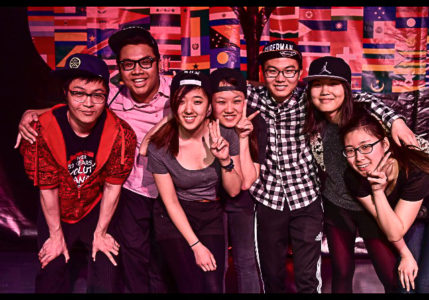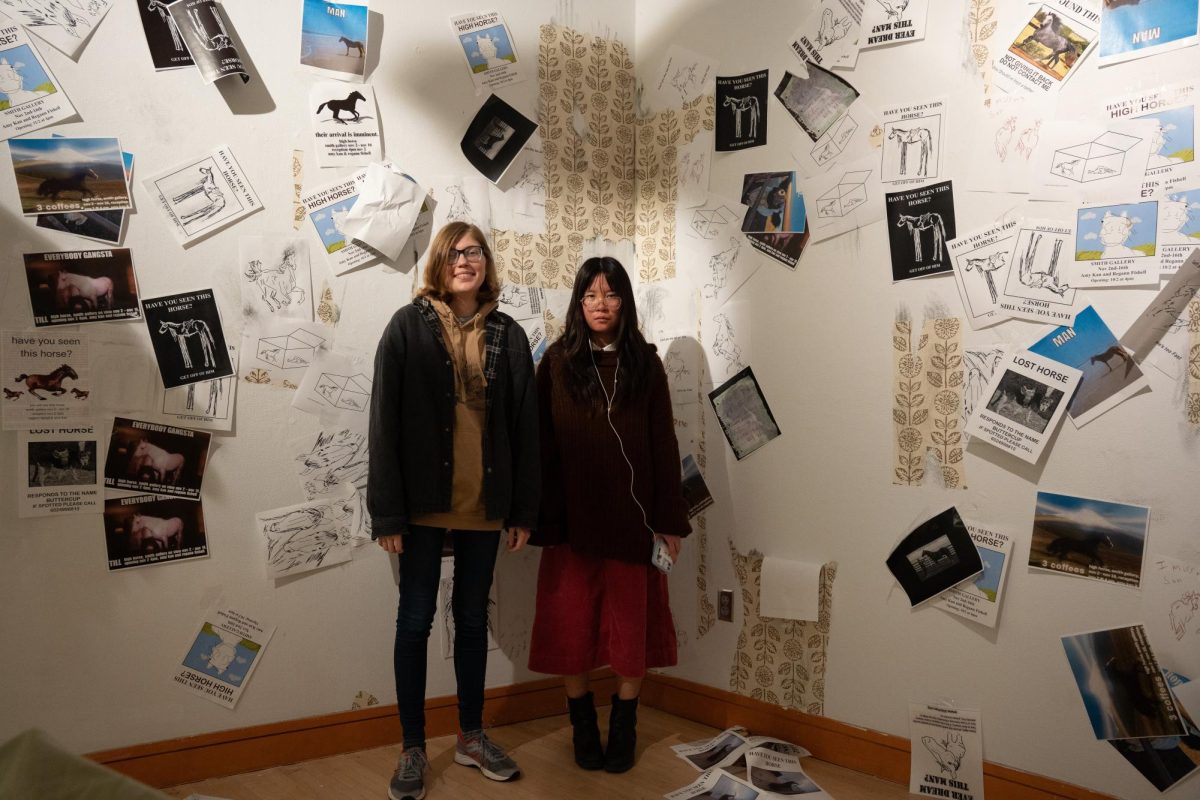Salseros de Grinnell
Aru Fatehpuria
fatehpur@grinnell.edu
Salseros de Grinnell is more than one may think. Some people think it is a club where you learn salsa dance. Others think it’s a place to eat chips and salsa. But for Katherine Ackerman ’18, it is much more than that.
Before joining the club in her first year at Grinnell, Ackerman was the kind of person to “stand in the corner at a dance.” Salsa changed it all. Now she pulls out moves from her repertoire at a Harris and even goes social dancing back home in Boise, Idaho and occasionally in Cedar Rapids and Des Moines.
The club, which meets every Tuesday from 7 to 8 p.m., holds introductory lessons for Salsa and Bachata and builds up to more complex moves and additional styles. Its main goal is to get people dancing. The club also puts on a few performances a year with a showcase in the spring. Salseros de Grinnell plans to perform at the Latin American Festival this year, as well as possibly hold a second multi-group dance performance at the end of the fall semester. The pieces range from solos to group partner work and are all self-choreographed. As of now, the club is led by Rachel Ward ’18, Emily Gold ’19 and Katherine Ackerman ’18 and has 10 members.
Ackerman says that Salsa not only gave her confidence, but also it has also served as a great opportunity to meet new and different people from all walks of life. It is an incredible transitional activity as almost every city has social dancing. Salseros de Grinnell is currently planning on at least one performance this semester, maybe two, but they’re easy to spot — you just need to follow the blasting Latin music.
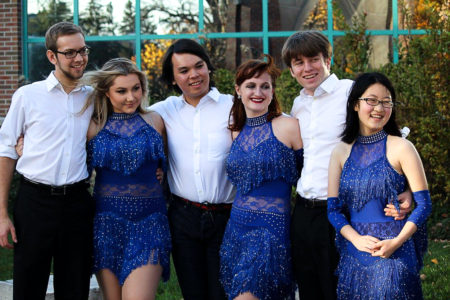
Swing Society
Kelly Page
pagekell@grinnell.edu
“If you’ve ever seen Dirty Dancing it’s like that, but not quite,” says Swing Club student leader John Zbaracki ’20. Grinnell’s swing dancers focus on East Coast Swing and the closely related Lindy Hop, partner dances set to music from the 40s and 50s.
“The thing I love about swing is there’s so much room for individualism and really making the dance between you and your partner special,” Zbaracki said. “You really control every aspect of it.”
The countless possibilities make swing a fun dance to watch and take part in. It might not be exactly like Dirty Dancing, but you could definitely have the time of your life.
Similarly to Contra, the Swing Society heads to Ames on an almost monthly basis to dance with Iowa State students. They meet every Wednesday from 7 to 8 p.m. in the Bucksbaum Dance Studio. To get involved email swing@grinnell.edu or reach out to the leaders of the society, John Zbaracki ‘20 and Miriam Tibbetts ’19.
Grinnell Bollywood Dhamaka
Keli Vitaioli
vitaioli@grinnell.edu
The Grinnell Bollywood Dhamaka group, begun in 2015 by Krishna Mudwari ’18 and Aditi Munshi ’19, is gearing up for a comeback this year at Grinnell.
After lying dormant last year, Bollywood Dhamaka hopes to expand its activity on campus with bi-monthly workshops. They feel this will be more beneficial to both the group members who are balancing other on-campus commitments and also to participants who will ideally be able to walk away from each workshop with a minute of choreography mastered.
The group also hopes to perform at the ISO Cultural Evening again, as they did in 2015. The dance style places an emphasis on facial expressions, something not emphasized in other groups on campus.
“What’s interesting about [Bollywood dance] is that in a lot of other dance styles you use a lot of your body to express something and it’s very interpretive,” said member Nandita Banik ’20. “Bollywood is interpretive but you use a lot of your face and expressions in comparison to a lot of other dance styles that makes it more unique. … In Bollywood dance it is very common when you’re dancing that you lip-sync the lyrics, which is not something you do in other dance styles.”
For Banik, the group is an accessible way to unwind, as the only necessity is a desire to learn about Bollywood dance and culture.
“I love how fun it is, how you can have a really stressful day and just relax and have fun and just go for it. Not to take away from the skill, because it is a skillful art form for sure, but also it is something that any could do if they wanted to enter into it, so I think that makes it more accessible to people,” Banik said. “That’s why it’s more fun to do it in a group because everyone can participate in it.”
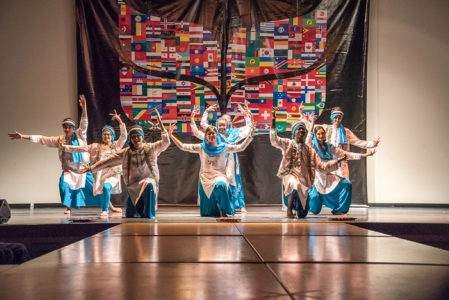
Contra Dance
Kelly Page
pagekell@grinnell.edu
Contra dance, an American dance style derived from English folk dancing, requires a caller who announces moves, which the dancers then carry out to the tune of fiddle music. It is similar to square dancing, except that you dance with a partner.
“We say if you walk you can Contra dance, because it’s very easy to learn and it’s very easy to teach,” said Contra Club student leader John Zbaracki ’20,
At the beginning of each weekly meeting, the Grinnell Contra Club walks through the steps of their first dance. Then the music starts and so do the steps announced by the caller. The dancers get through six songs for each hour-long meeting, with the option to either follow simple steps or add their own individual flourishes. In Contra, dancers do not remain with the same partner the entire time but instead interact with everyone in the room, making it a highly social dance style.
The Contra Club takes a trip to Ames once a month to dance with Iowa State. It will also hold a dance in Grinnell this November, featuring a live band and open to the public. As Zbaracki said, “You can come anytime and you don’t have to know anything—we’ll teach you.”
Contra meets from 7:30 p.m. to 8:30 p.m. in the Bucksbaum Dance Studio and is currently co-led by John Zbaracki ’20, Cameron Chen ’19 and Miriam Tibbetts ’19. To get involved, e-mail contradance@grinnell.edu or check out the website, https://grinnellcontra.wordpress.com/
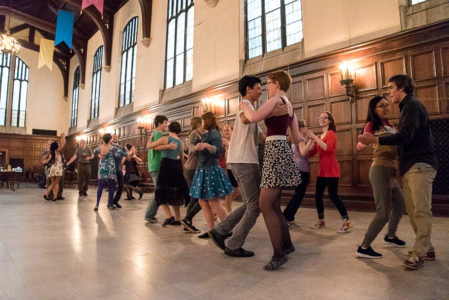
Photo contributed
KGY: Koreagraphy
Hallela Hinton-Williams
hintonwi@grinnell.edu
Grinnell’s Koreagraphy dance group (KGY) has been an institution at the College for many years. The group teaches and performs hip-hop and K-Pop style dance and choreography. Kat Su ’18, one of KGY’s co-leaders, says it is a friendly environment and a place where students should feel free to move their body in the way they want to. The club is tight-knit with 15 to 20 members and three co-leaders.
“[At ISO] the dance I taught was only four members, and the choreography was really, really special. Each person had their own solo, so it was nice to rotate around and give everyone the opportunity to be at the front of the stage and have the spotlight,” Su said. “We also did the stunt where we threw Bangjie [Wang ’20] over someone’s head, that got the crowd really loud. It was so much fun, we were really happy about it.”
The choreography is chosen by the co-leaders, who gather their material from K-Pop music videos and Korean choreographers. They then choose a mirrored version on YouTube and determine the dance’s alignment according to the club’s themes, level of difficulty and fun. This year, they are trying to implement new dances inspired by SM Entertainment’s “Spectrum” and various Korean choreographers.
“One thing that makes Koreagraphy, Koreagraphy is just within the name. We don’t necessarily teach technique as much. Korean dancing usually specializes in the synchronization of everyone because it is a very collective dance. Everyone has to be very detailed every single second,” Su said. “For us, we don’t concentrate on synchronization, we concentrate more on getting the moves down, getting to point A to point B.”
Anyone who is interested can join KGY at their twice-weekly practices. You can see them perform at the Mid-Autumn Festival in collaboration with the Chinese Student Association, at International Student Orientation, at one of the semester’s drag shows and at the dance showcase.
